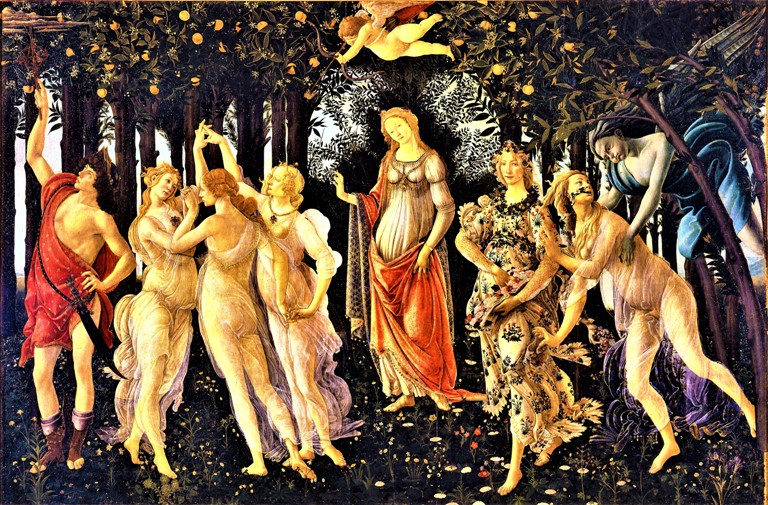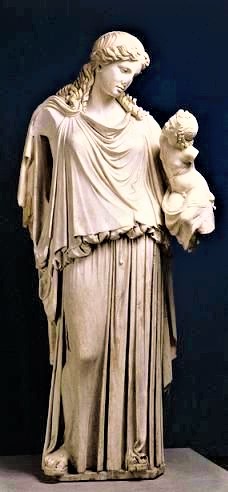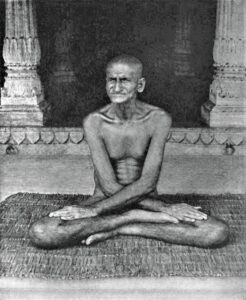“Peace”: Personal Perspectives in Humanoids? (Part 4)
TRANSCEND MEMBERS, 9 May 2022
Prof Hoosen Vawda – TRANSCEND Media Service
Personal Peace Is an Emotional Experience of Calmness [i]

Primavera circa 1482 (The word means spring in Italian) painting by Sandro Botticelli whose original name was Alessandro di Mariano Filipepi.
The painting shown above is also known as ‘Allegory of Spring’. It is believed that Botticelli created this piece of art circa 1482 and is reputed to be one of the prime examples of Renaissance art. Numerous individuals, including theologians, doctors, philosophers, psychiatrists, Renaissance artists, contemporary digital creators, philosophers and even cinematographers have attempted to interpret the painting. Many have come up with explanations, some of which are absurd. It is classified as a mythical allegory by some critics, while others describe it, as the transformation of a wintery season into spring. This painting is popular because of the use of color and different explanations offered over the centuries as to the intrinsic meaning and practical significant not only in the 15th century when it was painted, but also 500 years later in the present era. The bi-sided picturisation; the dark right and the happy left, depicting personal peace, contentment harmony, synchronisation of a group of humanoids and ultimate happiness. To the author, the painting evokes an emotion of personal Peace and Calmness, which are synonymous terms. “Peace” itself is a term used in a variety of contextual applications and definitions. A common usage, especially in the current context of the Russo-Ukrainian war, peace is used to represent the absence of war or conflict. Therefore, when warring countries eventually sign a peace treaty and are at literal “peace”, or when quarrelling friends and parties reconcile and are at peace with each other, a state of calmness or harmony is achieved. Botticelli’s Primavera is believed to be the most controversial painting in the world[1], as new theories are regularly postulated regarding the motivation and composition of the creation by the renaissance Master artist. In the final analysis the artwork epitomises the entity of “endogenous or intrinsic peace and calmness” as well as “sustained and lasting peace connections” between the humanoids, drawn therein. Essentially the famous painting conjures a greater vision of calmness and synchronization between the natural elements and humanoids, indeed a rare observation, in the 21st century.
In the previous three parts of the publications on Peace, as a general topic, the author highlights peace as defined scientifically by Professor Johan Galtung,[2] by firstly exploring the dictum that if you want peace, you must prepare for war according to the Roman General Vegetius Renatus and how the lack of preparedness resulted in the contemporary destruction of Ukraine, a former state of the old Soviet Union. The second part discusses the neuro-anthropology of peace[3] and the presence in humanoids of the primitive reptilian brain, in an evolutionary scale whereby, ontogeny, or personal, embryonic developmental history recapitulates phylogeny, or evolutionary developmental history, in a larger scaled scenario of the species and forms a neurological basis of peace disruption. In the third publication, the “labels” and tenets of the major religions of the world are proposed as the foundational reasons, for universal peace disruption, and religious diversity has created an environment ripe for genocides, cultural antagonisms and overt aggression as well as political persecutions, all in the guise of converting the “pagans and heathens” including separation of “pagan” children from their parent, to indoctrinate and convert them to a religion of the colonisers, over the centuries. This was executed on different continents, over the centuries, leading to inquisitions, most horrific and brutal tortures, dehumanisation of people of Middle Eastern origins, as it happened in Abu Ghraib prison[4],[5], by United States soldiers, following the occupation of Iraq.

Collage of prisoner abuses pictures by United States Soldiers in Abu Ghraib Prison in 2004, resulting in Intrinsic Peace Disruption
Few incidents have done more damage to America’s image in the world than the Abu Ghraib prisoner abuse scandal. In late April 2004, Americans got their first glimpse of the haunting photographs of Iraqi prisoners at the Abu Ghraib prison west of Baghdad: scenes of naked, humiliated prisoners piled on top of one another, some forced to assume sexual positions, all while American soldiers posed nearby, smiling at the camera.[6] The photos provoked an instant outcry around the world. In addressing the scandal, President Bush insisted that it was the fault of a few dishonorable soldiers, not a systematic problem with how the U.S. was managing the war in Iraq, but investigations suggest that the blame likely rises higher up the military’s chain of command. Some senior officials, such as General Janis Karpinski, who was in charge of military prisons in Iraq, were reprimanded and suspended. But the blame mainly fell on low-level soldiers, who were convicted and sent to prison for participating in sexual abuse, beatings, and other brutal acts. Then-Secretary of Defense Donald Rumsfeld said news of the abuse “stunned him.” But a military report by Major General Antonio Taguba found that the prison was overcrowded, undermanned, and short of resources, making accountability for prisoner treatment rare. Taguba also noted in 2004 that the Central Intelligence Agency had serious concerns about the kinds of interrogation techniques military forces used on detainees. But Taguba was not permitted to delve much deeper; an article in The New Yorker in 2007 reported that military investigators were not allowed to look into the role of Rumsfeld and other Department of Defense officials. What is known is that the Pentagon found out about the existence of the photos in January 2004 and Taguba filed his report in March. President Bush knew about the abuses at Abu Ghraib at least by March, but he did not address the issue until the media publicized it in late April. Congress found out about the abuse the same day the American public did. “This is entirely unacceptable,” said Senator Richard Lugar, a Republican of Indiana and then chairman of the Foreign Relations Committee. The scandal, Lugar added, “pushed international resentment and distrust of the United States to levels unprecedented in recent times.” The biggest failure, according to watchdogs: the lack of accountability for military officials who failed to stop or prevent the abuses. The White House press office did not respond to a request for comment, but has previously stated that the administration and the military acted quickly “to hold people to account and bring them to justice, and to also take steps to prevent something like that from happening again.” The list is endless and unfortunately unfolding the intrigues behind the regional and global conflicts, resulting in peace disruptions.
Moving back from 21st century to the period from the 14th century to the 17th century in Europe, is defined as The Renaissance. It marked a rebirth or revival of classical learning and wisdom. The wave of renaissance touched upon many areas of European civilisation, particularly in the areas of art, religion, literature, and politics. Renaissance marked an increased awareness of nature, a revival in learning which was all present in the medieval period but became prominent in the 15th and 16th centuries. Renaissance art was all about the representation of an individual view of a man. The period of the Renaissance saw some glorious works of many legendary artists, which are still revered today[7] and while most of the paintings depict a general theme of “Intrinsic Peace” , some of them display darker themes of punishment in hell and torture in dungeons by King Henry’s VIII wardens, showing genralised peace disruption. Currently, the terms is used widely by politicians to talk about “African Renaissance[8]” an era which is “reformatting Africa” from the shackles of colonial oppression and discrimination. This concept was first articulated by Cheikh Anta Diop[9] in a series of essays between 1946 and 1960. He was a Senegalese historian, anthropologist, physicist, and politician who studied the human race’s origins and pre-colonial African culture.[10] Alas, this physical, spiritual and mental reset has not been successful, principally because of peace disruption generated by ethnic, tribal conflicts, corruption, nepotism and power hoarding, which is widespread in Africa in its entirety, from Cape to Cairo. This causes peace disruption at personal and societal levels and is the main cause of African, mass humanoid migration towards Europe[11], with hundreds of deaths in the Mediterranean, due to drowning[12], hence the sea itself has become the source of a sordid legacy and heritage of the suffering of humanoids in the 21st century. This mass migration has resulted the second time, after an estimated 40,000 years. The author classifies it as “the second wave of mass migration of African Humanoids” due to intrinsic peace disruption, in their strife torn and poverty stricken, respective motherlands.[13]

Intrinsic African Peace Disruption caused by abject poverty, political strife, genocides, xenophobia, pollution and corruption, leading to the
Second Wave of Mass Humanoid Migration Out of Africa.
The first mass migration from Africa, also due to peace disruptions, at the time, which is not the scope of this paper, occurred millennia ago, when humanity was in transit, in search of the elusive “greener pastures”, while in a state of complete peace disruption and intrinsic despondency. The recent African origin paradigm suggests that the anatomically modern humans outside of Africa descended from a population of Homo sapiens migrating from East Africa roughly 70–50,000 years ago and spreading along the southern coast of Asia and to Oceania by about 50,000 years ago. Modern humans spread across Europe about 40,000 years ago.[14] Intrinsic Peace Disruption resulted in early humanoid migrations constitute the first wave of mass migrations and expansions of archaic and modern humanoids across continents. They are believed to have begun approximately two million years ago with the early expansions, out of Africa, by Homo erectus.[15] The phenotypic changes in the archaic humanoids, who migrated north into Europe, resulted as teleological, morphometric, physical changes and adaptations of their African bodies built for African conditions of their ambient. living environment. These externally manifest changes are demonstrated by the loss of excess melanin pigment from the skin, resulted in the emergence of fairer skinned humanoids, the narrowing of the Caucasian, nasal bridge, due to inhalation of the cooler, moisture laden, atmospheric air in the colder regions, as well as the different colours of the iris of the eyes, were all natural adaptations to accommodate the European climatic conditions, as a process of physical evolution ensuring survival of the migrated African humanoids in a totally different environmental conditions. These physical changes in humanoids, had to occur prior to establishment of peace, harmony and calmness. Hence, a significantly different humanoids type emerged, for example, based on the European conditions, at the time, who were now at peace.
Subsequent process changes in the neo-humanoids, post migration, involved a religious, social and cultural evolutions over the millennia, rather than physical changes on the base cohort. It also led to the emergence of multiple religions and the beginning of another odyssey of peace disruptions in Humanoids. This is exemplified by the mortal pursuit and population reduction of Catholics in United Kingdom, by the breakaway religious beliefs of the Tudor dynasty, following the excommunication by the His Holiness, Pope Paul III.[16]
This single development, changed the entire course of subsequent history, not only in United Kingdom but the entire world, The present day Catholic-Protestant conflict in Ireland has its roots deeply embedded in this Tudor-Papal disagreement, since 17th December 1538, finalis ing the threat of Pope Clements VII, when he threatened King Henry VIII with excommunication in March 1530, eight years later.[17] This Papal decree was the greatest, personal as well as exogenous peace disruptor, leading to the brutal executions of not only the Catholic clergy, but also ordinary citizens, as well, The statistics of executions during the Tudor reign, at the time, were absolutely abhorrent,[18] numbering 80,000 of which 60,000 most brutal executions, using innovative and heinous methods as well as special apparati, by King Henry VIII.
Additional definitions of personal peace also refer to rest. The Merriam-Webster Dictionary [19]defines peace as “a state of tranquility or quiet,” while the Oxford Dictionary [20]defines it as “the state of being calm or quiet.” Such as when describing a place as peaceful or saying your mind is at peace.[21] However, peace in the Bible is defined differently. Biblical peace is not just the absence of conflict or a state of rest. It means completeness or wholeness, and it points to the presence of something else, which is greater in the grand scheme of the universe,
To appreciate Biblical peace, it is necessary to closely examine the original Hebrew and Greek words. As regarding Peace in Hebrew, the word peace appears 237 times in the Old Testament with its first appearance in Genesis 15:15 “as for you, you shall go to your fathers in peace; you shall be buried in a good old age.” The Hebrew word translated as peace is shalom, and according to Strong’s concordance[22], it means completeness, soundness, and welfare. It comes from the root word shalam (shaw-lame’), which means making amends or making whole or complete. Shalam is often used in terms of making restitution. Take Exodus 22:4, for example; if a man stole an ox or a sheep from his neighbor, he was to restore or shalam what he had taken under the law. Therefore, having shalom means being in a state of wholeness or completeness, without any deficiency or lack. Shalom is frequently used in the Old Testament about the wellness of others. Sometimes it is translated as well, well-being or welfare such as in Genesis 37:14, 43:27, Judges 18:15, 1 Samuel 17:18, 2 Samuel 11:7, and more. In Jewish culture, people used shalom in greeting expressions such as shalom Aleichem which means “well-being be upon you,” or “may you be well.” Jesus and New Testament writers often greeted one another and said farewell with peace (John 20:19).
The word peace in the New Testament is from the Greek word eiréné (i-ray’-nay). According to Strong’s Concordance, eiréné[23] means one, peace, quietness, and rest. It originates from the root word eirō, which means to join, or tie together into a whole.
Therefore, eiréné means unity; it is bringing multiple parts together to form a whole or set it as one again. For example, two friends who reconcile after a fight make eiréné; that is, they come back together, and their relationship is whole.
Eiréné first appears in the New Testament in Matthew 10:13 “And if the house is worthy, let your peace come upon it, but if it is not worthy, let your peace return to you.” It appears 91 other times in the new testament in every book except 1 John. In some translations, Mark 4:39 says, “Peace! Be still,” but the Greek word used in that verse is not eiréné but siópaó, which means to be silent. The English word serene, which means calm and peaceful, originates from eiréné.
Conceptually, the peace of God is different from the peace of the world. Biblical peace is more than just the absence of conflict; it is taking action to restore a broken situation. It is more than a state of inner tranquility; it’s a state of wholeness and completeness. Biblical peace is an entity which humanoids cannot create on our own; it is a fruit of the Spirit. God is the source of peace, and one of His names is Yahweh Shalom (Judges 6:24), which means the LORD Is Peace. Jesus is the prince of peace (Isaiah 9:6), and He dispenses peace in three different ways. These can be enumerated as follows, for ease of reference:-
- Peace with God (Romans 5:1). Due to our sins, we were enemies of God and were separated from Him (Ephesians 2:13), but Jesus restored our relationship when He took on our sins and died our death on the cross (Ephesians 2:14). He provided a path for reconciliation with God, and now we are joined to God (Romans 5:10) and can fellowship with Him (1 John 1:3).
- Peace with others: Jesus is our peace with others. In Him, we have reconciliation with others, live at peace with them (Colossians 1:19-20), have fellowship with one another (1 John 1:9), and can live with others in unity and one accord through the bonds of peace (Ephesians 4:3). He empowers us by His Spirit to be peacemakers with our neighbors, friends, and foes.
- Peace within ourselves: Jesus is our peace within. In Him, we are a new creation (2 Corinthians 5:17), and He is making us whole and complete like Him (Philippians 1:6, 1 Thessalonians 5:23-24). When trials come to tear us apart, He is our peace that keeps us together (John 16:33).
In all religions, peace is the central theme which the respective religious doctrines propagate intensely. The concept of peace is reflected in the relevant scenarios in the afterlife of all humanoids after their demise. Good deeds in this world will ensure Peace in the hereafter, while bad deeds will earn humanoids, absence of Peace and agitation with metaphorical and immense suffering, Therehow, the different scriptures ensure that there is total compliance with the religious doctrines and beliefs, by the community. Peace appears 329 times in the Bible, with the highest occurrence of 30 times in the book of Isaiah.
In Islam, the philosophy of Peace plays a major role in defining the behavioural patterns and role modelship of humanoids in the family, the community and the greater society. This importance of peace and tranquility are reflected in the Islamic greetings of “Salaam”, meaning “peace be with you”. The Arabic word salaam originates from the same root as the word Islam.[24] The word silm also means the religion of Islam in Arabic, and the phrase “he entered as-silm (peace)” means “he entered Islam.” One Islamic interpretation is that individual personal peace is attained by submitting one’s will to the Will of Allah or God,[25] The ideal society according to the Quran is Dar as-Salam, literally, “the house of peace” of which it intones: “And Allah invites to the ‘abode of peace’ and guides whom He pleases into the right path.”[26] According to Ibn Hajar al-Haythami[27], there will be an era in which justice, plenty, abundance, well-being, security, peace, and brotherhood will prevail among humanity, and one in which people will experience love, self-sacrifice, tolerance, compassion, mercy, and loyalty. The last Prophet Muhammad of Islam said that this blessed period will be experienced through the mediation of the Mahdi, who will come in the end times to save the world from chaos, injustice, and moral collapse. He will eradicate godless ideologies and bring an end to the prevailing injustice. Moreover, he will make religion like it was in the days of Prophet Muhammad, cause the Quran’s moral teachings to prevail among humanity, and establish peace and well-being throughout the world.[28] The Mahdi is an eschatological, messianic figure in Islam who is believed to appear at the end of times to rid the world of evil and injustice. He is said to appear shortly before the Prophet ʿĪsā (Jesus) and be a righteous caliph over all Muslims.[29]
Judaism’s religious texts overwhelmingly endorse compassion and peace, and the Hebrew Thora contains the well-known commandment to “love thy neighbor as thyself”. In fact, the love of peace and the pursuit of peace is one of the key principles in Jewish law, as in Islam.[30]
Hinduism is based on the principle of non-dualism, which means that in this world, the Creator and the Creation are not two different entities. It is rather the same reality which is manifested in different things and different beings in this world.[31] Hence, the human spirit is a miniscule component of the Lord and returns to Him, upon the demise of the physical body. The peaceful aspect about Hinduism is the recitation of Peace-Mantras at every function. The Peace Chants invoke peace equally on all sentient beings and even to the trees and the environment. It does not only include humanoids[32] Hinduism advocates the importance of achieving inner peace within oneself, before attempting to spread peace throughout the community.[33]
The Bottom Line is what has been quoted by Swami Bhaskarananda Saraswati (1833–1899) [34] The rulers think that punishing the peace-breakers will bring peace, as experienced in Hong Kong. The oppressed think that eliminating the oppressors will ensure peace as in Palestine.
The nations think that destroying or subduing the enemy nations will create peace as in Ukraine, following the Russian invasion. However, the wise say that ever-enduring peace can never be obtained through external means. One who has found inner peace has indeed found peace that abides forever.
This elusive intrinsic peace could be achieved through spiritual discipline, whereby humanoids must exfoliate jealousy, anger, envy, hatred, aggression, belligerence, nefarious intent, cynicism, negativity and pursuit of materialism. These primitive drives can only be renunciated by controlling the Reptilian Brain, found as a vestige in the cranial cavity of modern humanoids. This is achieved by a continuous array of inhibitory neurological impulses being discharged from the higher level of functioning of the neo-cortex which humanoids are richly endowed with, either through complex evolutionary processes, ensuring not only the survival of the fittest, but also the survival of the wisest, on Earth, or through Divine intervention, believe what you will. Humanoids are made of up three parts, which include, firstly, The Physical Body, which decomposes as soon as the heart stops beating, and is not eternal, secondly it has The Soul, or conscience. This may be good and angelic, or bad, putrid and devilish, In the Godly realm, in the afterlife, the soul is accountable for its deeds and will be judged, accordingly, being admitted to the Glorious Heaven for a good account or to the torturous Hell fire, fs the bad deeds outweigh the good deeds. The third component of Humanoids is The Spirit infused into Adan, the Lord’s human prototype creation, from base clay, at the time of Genesis. The spirit is part of the Lords composition, it is eternal, is pure and remains as an uncontaminated entity, by the body and the souls. Peace is a fruit of the spirit but the fruit of the Spirit is love, joy, peace, patience, kindness, goodness and faithfulness. Humanoids must actively seek peace and make peace. Turn away from evil and do good; seek peace, pursue it and sustain it, as stated in Galatians, (5:22, modified). Romans 12:18 states: So then let us pursue what makes for peace and for mutual upbuilding.
One who has found peace within, transmits peace to others by one’s own life’s example, though one be not aware of it. Therefore, say the wise, may all try to create intrinsic peace within, before trying to create any temporary or superficial peace in the world, through extrinsic means. Similarly, all the other religious doctrines, including Traditional African Religions, share a similar philosophy regarding Peace in Humanoids.
References:
[i] Personal quotation by the author 2022.
[1] https://web.facebook.com/274921182645831/posts/portuguese-in-india-the-goa-inquisition-a-forgotten-chapter-of-the-bloody-histor/1776885835782684/?_rdc=1&_rdr
[2] https://www.transcend.org/tms/2022/04/peace-the-odyssey-of-the-relentless-pursuit-of-humanoids-of-an-elusive-philosophy-part-1/
[3] https://www.transcend.org/tms/2022/04/peace-the-neuro-anthropology-of-peace-and-the-innate-proclivity-of-humanoids-to-generate-conflict-part-2/
[4] https://en.wikipedia.org/wiki/Abu_Ghraib_prison#:~:text=Abu%20Ghraib%20prison%20was%20opened%20in%20the%201950s,later%20the%20United%20States%20to%20hold%20political%20prisoners.
[5] https://publicintegrity.org/politics/abu-ghraib-prison-scandal-2/
[6] https://publicintegrity.org/politics/abu-ghraib-prison-scandal-2/#:~:text=Few%20incidents%20have,from%20happening%20again.%E2%80%9D
[7] https://www.parblo.com/blogs/guides/10-most-famous-paintings-of-the-renaissance
[8] https://en.wikipedia.org/wiki/African_Renaissance
[9] https://en.wikipedia.org/wiki/Cheikh_Anta_Diop
[10] https://www.bing.com/search?q=cheikh+anta+diop&qs=AS&pq=cheikh+anta+diop&sc=6-16&cvid=8BAD36C2DBCF49A2AF0ADF8200A7860F&FORM=QBRE&sp=1#:~:text=7%20February%201986)-,was%20a%20Senegalese%20historian%2C%20anthropologist%2C%20physicist%2C%20and%20politician%20who%20studied%20the%20human%20race%27s%20origins%20and%20pre%2Dcolonial%20African%20culture.,-Diop%27s%20work%20is
[11] https://ec.europa.eu/info/strategy/priorities-2019-2024/promoting-our-european-way-life/statistics-migration-europe_en
[12] https://www.natureasia.com/en/nmiddleeast/article/10.1038/nmiddleeast.2018.128
[13] https://en.wikipedia.org/wiki/Poverty_in_Africa#:~:text=Poverty%20in%20Africa%20is%20the%20lack%20of%20provision,per%20capita%2C%20despite%20a%20wealth%20of%20natural%20resources.
[14] https://www.bing.com/search?q=humanoid+migration+towards+Europe&qs=n&form=QBRE&msbsrank=6_6__0&sp=-1&pq=humanoid+migration+towards+europe&sc=6-33&sk=&cvid=9A95F4BCAC2B4654A2BE5E8CA09462DF#:~:text=See%20all%20images-,Early%20human%20migrations,-Early%20human%20migrations
[15] https://en.wikipedia.org/wiki/Early_human_migrations
[16] https://www.bing.com/search?q=which+pope+excommunicated+king+henry+viii&qs=UT&pq=which+pope+excommunicated+king+henry&sc=1-36&cvid=BF7A71869DA64FEEA974646D11238201&FORM=QBRE&sp=1#:~:text=viii%20ge%C3%ABkskommunikeer%20het%E2%80%9D-,Pope%20Paul%20III,-According%20to%204
[17] https://www.history.com/this-day-in-history/pope-clement-vii-forbids-king-henry-viii-from-remarrying
[18] https://www.tudornation.com/how-many-people-were-executed-by-the-tudors/
[19] https://www.merriam-webster.com/
[20] https://www.oxfordlearnersdictionaries.com/
[21] https://www.academia.edu/78133911/Whose_Realm_His_Bishop_Orthodox_Patriarch_s_Flock_beyond_the_Borders_of_the_Ottoman_Empire_in_the_Seventeenth_Century_IN_Entangled_Confessionalizations_Dialogic_Perspectives_15th_18th_Cent_ed_T_Krsti%C4%87_D_Terzio%C4%9Flu_Gorgias_Pr_2022_215_231
[22] https://en.wikipedia.org/wiki/Strong%27s_Concordance
[23] https://en.wikipedia.org/wiki/Eirene_(goddess)
[24] https://en.wikipedia.org/wiki/Online_Etymology_Dictionary
[25] https://en.wikipedia.org/wiki/Peace_in_Islamic_philosophy#:~:text=%22What%20Does%20%22Islam%22%20Mean%3F%22.%20Classical%20Arabic.%2020%20June%202020.
[26] Qur’an 10:25 Qur’an 10:25 Archived 2008-11-28 at the Wayback Machine; Lewis, Bernard, The Crisis of Islam, 2001 Chapter 2
[27] https://en.wikipedia.org/wiki/Ibn_Hajar_al-Haytami
[28] https://ahmadianswers.com/ahmad/truth/hadith/nameofimammahdi/#:~:text=The%20hadith%20says%20that%20the%20Mahdi%20would%20be,Mahdi%20would%20be%20of%20Persian%20lineage%2C%20not%20Arab
[29] https://en.wikipedia.org/wiki/Mahdi
[30] https://en.wikipedia.org/wiki/Judaism_and_peace
[31] https://www.bing.com/search?q=peace+in+hinduism&qs=SC&pq=peace+in+hiduism&sc=1-16&cvid=96DF07700118464A863F982F333C912B&FORM=QBRE&sp=1#:~:text=Non%2Ddualism-,Peace%20in%20Hinduism%20Hinduism%20is%20based%20on%20the%20principle%20of%20non%2Ddualism%2C%20which%20means%20that%20in%20this%20world%2C%20the%20Creator%20and%20the%20Creation%20are%20not%20two%20different%20entities.%20It%20is%20rather%20the%20same%20reality%20which%20is%20manifested%20in%20different%20things%20and%20different%20beings%20in%20this%20world.,-PEACE%20IN%20DIFFERENT
[32] https://www.quora.com/What-is-the-ultimate-peace-in-Hinduism
[33] https://www.bing.com/search?q=peace+in+hinduism&qs=SC&pq=peace+in+hiduism&sc=1-16&cvid=96DF07700118464A863F982F333C912B&FORM=QBRE&sp=1#:~:text=of%20ways.%20But-,Hinduism%20advocates%20the%20importance%20of%20achieving%20inner%20peace%20before%20attempting%20to%20spread%20peace%20throughout%20the%20community.,-Senior%20Hindu%20monk
[34] https://en.wikipedia.org/wiki/Swami_Bhaskarananda_Saraswati
______________________________________________
Read: Part 1 – Part 2 – Part 3
 Professor G. Hoosen M. Vawda (Bsc; MBChB; PhD.Wits) is a member of the TRANSCEND Network for Peace Development Environment.
Professor G. Hoosen M. Vawda (Bsc; MBChB; PhD.Wits) is a member of the TRANSCEND Network for Peace Development Environment.
Director: Glastonbury Medical Research Centre; Community Health and Indigent Programme Services; Body Donor Foundation SA.
Principal Investigator: Multinational Clinical Trials
Consultant: Medical and General Research Ethics; Internal Medicine and Clinical Psychiatry:UKZN, Nelson R. Mandela School of Medicine
Executive Member: Inter Religious Council KZN SA
Public Liaison: Medical Misadventures
Activism: Justice for All
Email: vawda@ukzn.ac.za
Tags: Peace
This article originally appeared on Transcend Media Service (TMS) on 9 May 2022.
Anticopyright: Editorials and articles originated on TMS may be freely reprinted, disseminated, translated and used as background material, provided an acknowledgement and link to the source, TMS: “Peace”: Personal Perspectives in Humanoids? (Part 4), is included. Thank you.
If you enjoyed this article, please donate to TMS to join the growing list of TMS Supporters.

This work is licensed under a CC BY-NC 4.0 License.

